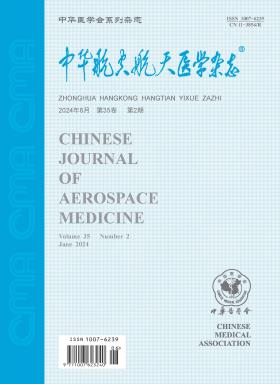Research on positive acceleration induced rabbit lumbar disc degeneration by means of quantized axial loading device
引用次数: 0
Abstract
Objective To estimate the influence of simulated positive acceleration on rabbit lumbar disc degeneration by means of a controllable axial loading device,and to provide experimental reference for the further study on pilot's lumbar disc degeneration.Methods Twenty four New Zealand white rabbits were randomly divided into 4-week group (n=8),8 week group (n=8) and control group (n =8).A self-designed controllable axial loading device was utilized to impose 40 N compress forces on the discs of the rabbits for 15 s,10 times a day for 4 and 8 weeks in two experimental groups respectively but in control group.Degeneration of the discs was evaluated by disc height index (DHI),magnetic resonance imaging (MRI) scanning results,type Ⅰ and type Ⅱ collagen that got from haematoxylin and eosin (HE) staining,and immunohistochemical staining.Results ① Compared with that of control group and 4-week group,DHI of 8-week group had statistical difference (P< 0.01).There was no DHI difference between 4-week group and control group (P>0.05).②Compared with that of control group and 4 week group,Pfirrmann's system (MRI) of 8 week group showed statistical difference (Z=3.655,3.330,P<0.01),but the difference between 4-week group and control group (P>0.05).③Compared with that of control group and 4-week group,Thompson grade of 8-week group showed statistical difference (Z=2.893,2.095,P<0.05).Thompson grade did not significantly differ between 4-week group and control group (P>0.05).④Immunohistochemical staining showed that the degeneration of type Ⅱ collagen in 8-week group was more serious.Staining for type Ⅰ collagen showed that the distribution of positive staining increased in nucleus pulposus.Conclusions According to DHI,MRI and pathology results,the lumbar disc of the rabbits in experimental group appear early degeneration,and become more serious as the loading time prolonged.It provides a good experimental reference for the further study of pilot's lumbar disc degeneration. Key words: Rabbit; Intervertebral disc; Magnetic resonance imaging; Acceleration; Model,animal量化轴向加载装置对正加速度诱导兔腰椎间盘退变的研究
目的利用可控轴向加载装置评估模拟正加速度对兔腰椎间盘退变的影响,为进一步研究飞行员腰椎间盘退变提供实验参考。方法将24只新西兰大白兔随机分为4周组(n=8)、8周组(n=8)和对照组(n=8)。采用自行设计的可控轴向加载装置,实验组和对照组分别对兔椎间盘施加40 N的压缩力,持续15 s,每天10次,持续4周和8周。采用椎间盘高度指数(DHI)、磁共振成像(MRI)扫描结果、血红素和伊红(HE)染色所得Ⅰ型和Ⅱ型胶原蛋白及免疫组化染色评价椎间盘退变情况。结果①8周组DHI与对照组和4周组比较,差异有统计学意义(P< 0.01)。4周组与对照组DHI差异无统计学意义(P>0.05)。②与对照组、4周组比较,8周组Pfirrmann’s system (MRI)评分差异有统计学意义(Z=3.655、3.330,P<0.01), 4周组与对照组比较差异有统计学意义(P>0.05)。③与对照组和4周组比较,8周组汤普森评分差异有统计学意义(Z=2.893、2.095,P<0.05)。4周组与对照组汤普森评分差异无统计学意义(P>0.05)。④免疫组化染色显示,8周组Ⅱ型胶原变性更为严重。Ⅰ型胶原染色显示髓核内阳性染色分布增加。结论经DHI、MRI及病理检查,实验组家兔腰椎间盘出现早期退变,并随负荷时间延长而加重。为进一步研究飞行员腰椎间盘退变提供了良好的实验参考。关键词:家兔;椎间盘;磁共振成像;加速度;动物模型,
本文章由计算机程序翻译,如有差异,请以英文原文为准。
求助全文
约1分钟内获得全文
求助全文
来源期刊

中华航空航天医学杂志
航空航天医学
自引率
0.00%
发文量
2962
期刊介绍:
The aim of Chinese Journal of Aerospace Medicine is to combine theory and practice, improve and popularize, actively advocate a hundred flowers bloom and a hundred schools of thought contend, advocate seeking truth from facts, promote the development of the related disciplines of aerospace medicine and human efficiency, and promote the exchange and penetration of aerospace medicine and human efficiency with other biomedical and engineering specialties.
Topics of interest for Chinese Journal of Aerospace Medicine include:
-The content of the journal belongs to the discipline of special medicine and military medicine, with the characteristics of multidisciplinary synthesis and cross-penetration, and mainly reflected in the aerospace industry, aerospace flight safety and efficiency, as well as the synthesis of special medicine, preventive medicine, environmental medicine, psychology, etc.
-Military aeromedicine (Air Force, Navy and Army aeromedicine) and civil aeromedicine, with a balance of aerospace medicine are the strengths of the journal.
-The change in aerospace medicine from a focus on promoting physiological compensatory adaptations to enhancing human performance under extreme environmental conditions is what the journal is helping to promote.
-The expansion of manuscripts in high altitude medicine is also a special emphasis of the journal.
 求助内容:
求助内容: 应助结果提醒方式:
应助结果提醒方式:


